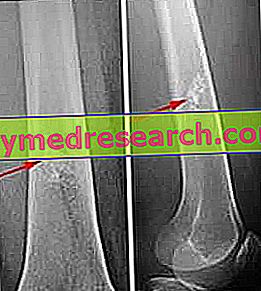What is conjunctivitis?
Among the diseases of the eye, conjunctivitis undoubtedly covers an important position: it is in fact the most common ocular inflammation.

More precisely, conjunctivitis is an inflammatory process affecting the conjunctiva, the thin, transparent mucous membrane that covers the anterior surface of the eye (with the exception of the cornea) and the inner eyelid area. The characteristic symptom of the various forms of conjunctivitis is the evident redness of the eyes (hyperemia): when the conjunctiva suffers an insult - be it infectious, irritative or allergic - the thin blood vessels of the eyeball, inflamed, cause the reddening of the part white of the eye (sclera).
In its common form, conjunctivitis is a disease of easy resolution and only rarely dangerous; despite what has been said, the disease always requires a specific cure, which must be undertaken from the earliest symptoms to avoid future complications or relapses.
Causes and classification
There are numerous forms of conjunctivitis, essentially distinguished on the basis of the cause of origin:
- BACTERIA CONJUNCTIVITY : the cause lies mainly in an infection caused by bacteria. The germs most involved in the insult are staphylococci, streptococci, Haemophilus influenzae, Neisseria gonorrhoea and Pseudomonas aeruginosa . Less frequently, bacterial conjunctivitis is caused by Chlamydia trachomatis (typical conjunctival infection of the newborn *).
* NEONATAL CONJUNCTIVITY is essentially caused by a bacterial infection acquired during childbirth. The main causative agent is Chlamydia trachomatis : it is estimated that 30-40% of babies born to chlamydial mothers develop neonatal bacterial conjunctivitis. In addition to this pathogen, H. influenzae, N. gonorrhoeae and S. aureus may also be possible causative factors.
- VIRAL CONJUNCTIVITIS : in this case, the conjunctiva infection is the result of a viral insult. The main culprits are undoubtedly Herpes simplex (the same virus as herpes labialis and genitalis) and Herpes zoster, the main etiological agent of St Anthony's fire. Although quite rare, some patients exhibit an unusual form of viral conjunctivitis caused by the contagious mollusc (an infection favored by DNA viruses belonging to the Poxviridae family).
- IRRITATIVE CONJUNCTIVITY : direct contact between the eye and some irritants can cause this form of conjunctivitis. In this case, the conjunctiva can become inflamed both after contact with chemical products, caustic or corrosive, and due to the penetration of small objects, eyelashes or dust into the eye. Sometimes, even prolonged exposure to light sources (eg solar / artificial tanning) can irritate the conjunctiva, creating inflammation and discomfort.
- ALLERGIC CONJUNCTIVITY : typical of the spring period, the inflammation of the conjunctiva on an allergic basis is the result of any form of allergy to pollens, grasses, dust and so on. Allergic conjunctivitis, which affects both eyes, can be prevented by following a specific prophylactic therapy before the arrival of spring. Allergic conjunctivitis can also occur due to the use of inadequate cosmetics such as mascara, aggressive eyeshadows and foundations.
Symptoms
To learn more: Conjunctivitis symptoms
All the various forms of conjunctivitis have in common some recurrent symptoms: first of all the reddening of the eyes (hyperemia) and the lacrimation, often quite abundant. Also photophobia, that is hypersensitivity and intolerance to light, is a symptom common to almost all forms of conjunctivitis (except for some bacterial variants).
Instead itching, swelling and follicles are typical of allergic conjunctivitis ; otherwise, the viral form is distinguished by the characteristic enlargement of the periauricular and submandibular lymph nodes and by the rather scarce ocular secretions.
The conjunctival infections induced by bacteria are easily recognizable by the emission of a yellowish, sometimes greenish, sticky secretion from the eye: these dense secretions tend to "stick" the lashes, making it difficult to open the eyelids.
Complications
In general, conjunctivitis is an easily resolved infectious process: when treated accurately, even better if from the first symptoms, it resolves itself within a short time without complications.
However, in some patients (in particular the immunocompromised, the weak and the seriously ill), the conjunctivitis occurs in more severe forms: in this case, the clinical picture of the subject can degenerate. For example, complicated allergic conjunctivitis can progress to involving the cornea (keratitis); in other cases, the infection can create eyelid dermatitis and corneal ulcer (corneal lesion responsible for corneal opacification, blurred vision and scarring in the eye).
Viral conjunctivitis may also be accompanied by general symptoms, such as fever, malaise and muscle pain. Also remember that viral conjunctivitis is extremely contagious; therefore, to avoid the spread of infection, it is recommended to scrupulously respect all the hygienic rules.
Although the possibility is rather remote, complicated and untreated conjunctivitis can cause permanent loss of vision.
Diagnosis
Differential diagnosis is essential to assess the most appropriate therapy for that specific form of conjunctivitis.
The various diagnostic tests, recommended in all cases of suspected conjunctivitis, include culture tests, smears for cytological (cellular) analysis and special bacterial GRAM staining.
In general, the diagnosis begins with a meticulous analysis of the eye: here, the degree of redness and palpebral / conjunctival swelling will be evaluated.
In the case of chlamydial conjunctivitis in adults and newborns, a series of immuno-diagnostic tests are performed, possibly supported by culture analyzes.
In more complex cases, where the possibility of sebaceous carcinoma is palpable, a biopsy of the bulbar conjunctiva is recommended.
Before undertaking any treatment, the differential diagnosis between conjunctivitis and other diseases involving similar symptoms is important, such as in particular: uveitis, glaucoma, keratitis (corneal inflammation), eye trauma and scleritis (inflammation of the ocular sclera, not necessarily related to conjunctivitis).
Therapy
To learn more: Drugs for the treatment of conjunctivitis
After having ascertained the type of conjunctivitis, it is possible to proceed with specific therapy. Eye drops and ophthalmic ointments are the drugs of first choice for the treatment of all forms of conjunctivitis; clearly the type of eye drops must be evaluated based on the cause that inflamed the conjunctiva.
Bacterial conjunctivitis should be treated with a topical therapy based on antibiotic eye drops, possibly combined with corticosteroid drugs able to exert a powerful anti-inflammatory action.
The viral form of conjunctivitis, on the other hand, should generally be treated by instillation into the eye of common analgesic and anti-inflammatory eye drops (NSAIDs) for symptom control. Antiviral drugs are not always essential for healing because very often the infection regresses spontaneously within 3-7 days. Cortisone eye drops, in this case, are not recommended because, in the presence of a viral ophthalmic infection, these drugs could cause serious problems to the internal structures of the eye.
To relieve redness, itching and eye irritation, allergic conjunctivitis requires the topical administration of antihistamine drops, possibly accompanied by a symptomatic therapy based on decongesting eye drops and vasoconstrictors (to reduce conjunctival hyperaemia and induce a narrowing of the vessels). blood vessels of the conjunctiva). Seasonal allergic conjunctivitis can be prevented by following a prophylactic therapy based on antihistamine drugs before the arrival of spring.
Please note
To speed up recovery it is necessary to strictly follow the indications suggested by the doctor. Although not all drugs intended for the treatment of conjunctivitis are subject to mandatory medical prescription, it is always important to seek the advice of a specialist: self-treatment is strongly discouraged since it risks generating unpleasant side effects. An inadequate / immoderate use of eye drops, in the long run, can cause a worsening of eye congestion.
Remedies and advice
To learn more: Conjunctivitis: All Effective Remedies »
Here are some remedies and practical tips to speed up the health of the eyes affected by conjunctivitis:
- To reduce swelling and conjunctival congestion, delicate chamomile packs are very suitable for immediate relief. It is recommended to use a clean cotton ball for each pack.
Watch the video
X Watch the video on youtube- To strengthen the immune system, we recommend taking yogurt with live lactic ferments or a probiotic in case of prolonged antibiotic therapy
- Avoid the mixed use of toiletry items such as towels and wipes to minimize the risk of disclosing the infection
- Avoid using make-up products around the infected eye until complete recovery
- Protect your eyes with sunglasses with UV filters
- Prevent the spout of the eye drops from coming into contact with any eye structure: this is important both to avoid traumatizing the eye and to minimize the risk of self-contamination
- Wash your hands thoroughly before touching your eyes
- Do not use expired or open eye drops for more than 7 days
- Avoid wearing contact lenses for the entire duration of conjunctivitis therapy



